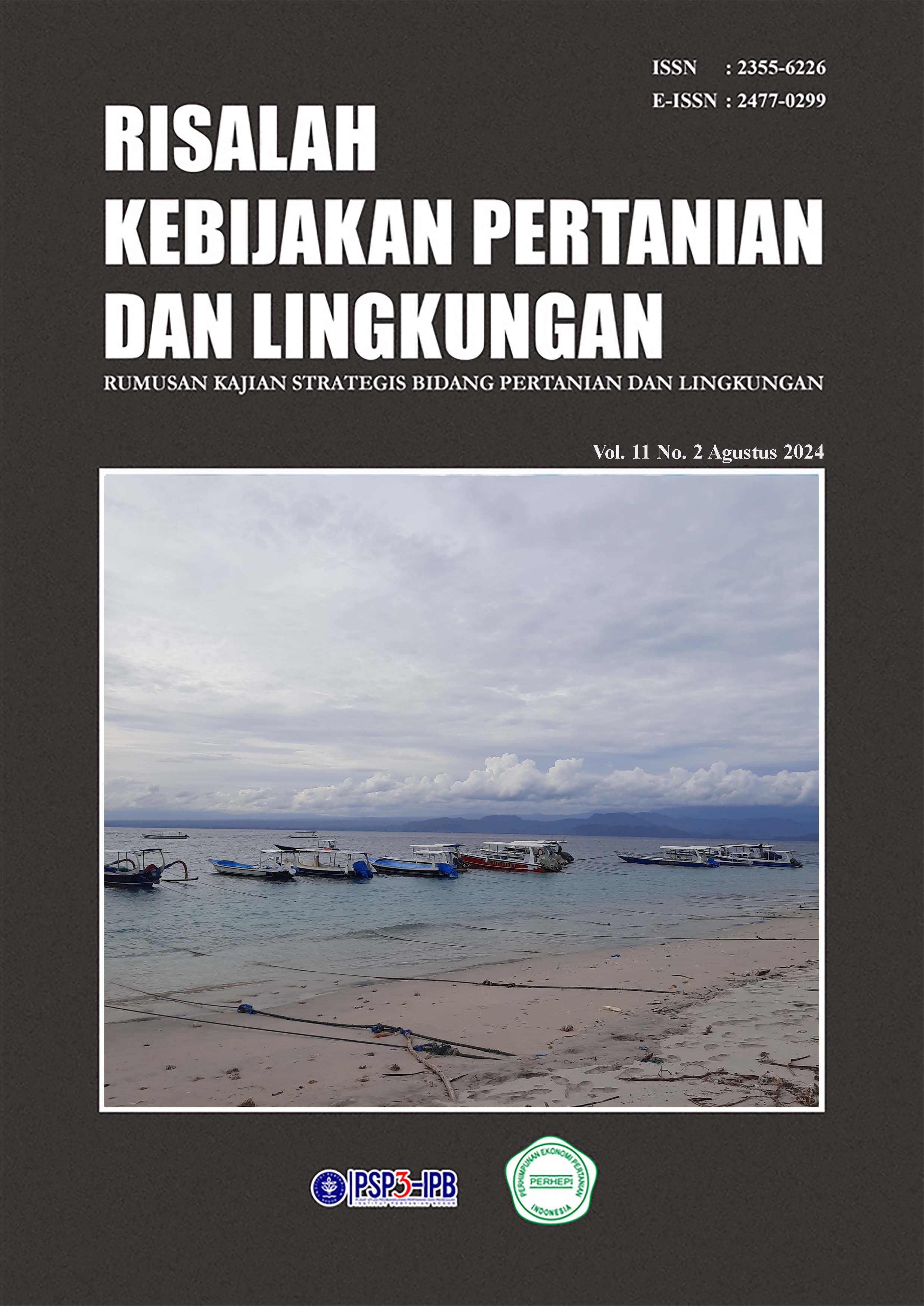KOTA HUTAN IBU KOTA NUSANTARA DALAM MODEL DESAIN RAMAH LINGKUNGAN
Abstract
The Archipelago Capital (IKN) as the new capital is on the island of Kalimantan, replacing Jakarta. The IKN development carries the forest city concept which pays attention to environmentally friendly aspects. This writing aims to apply the International Environmental Organization Program in the model and form transmission mechanism and apply the Law of the Republic of Indonesia Number 32 of 2009 in the model and form the transmission mechanism. The endogenous and exogenous variables required for simultaneous equations are by theory and empirical experience. The model built consists of 16 endogenous variables (G) and 29 predetermined variables. This means that in model (K) there are 45 variables. There are 14 exogenous and 16 endogenous variables, so (M) totals 30 variables. Thus, (K – M) = (G – 1). This means that the model is identified precisely and is suitable for analysis using the Two Stage Least Squares Method. Application of the International Environmental Organization Program, namely establishing the International Eco Green University to function in the field of research, development and preservation of flora, fauna and marine biota endemic to the island of Kalimantan. The application of the Environmental Law is realised starting from the process of providing residential or office infrastructure in the form of condominiums to the technology for processing liquid and solid waste materials into organic materials for agricultural fertiliser, biogas, animal feed and land fisheries. The transmission mechanism is from achieving added value in all business fields to the growth of IKN's Gross Regional Domestic Product.
Metrics
Downloads
References
Aulia R, Kaswanto RL, Arifin HS, Mosyaftiani A, Syasita N, Wahyu A, Wiyoga H. 2023. Assessing the Benefits and Management of Urban Forest in Supporting Low Carbon City in Jakarta, Indonesia. Biodiversitas Journal of Biological Diversity, 24(11). https://doi.org/10.13057/biodiv/d241136 DOI: https://doi.org/10.13057/biodiv/d241136
Badan Standardisasi Instrumen Lingkungan Hidup dan Kehutanan 2020. Membangun Standar Forest City Ibu Kota Nusantara. https://bsilhk.menlhk.go.id
Dewi NMNBS. 2021. Analisis Limbah Rumah Tangga Terhadap Dampak Pencemaran Lingkungan. Program Studi Teknik Sipil Kampus Mataran UNMAS Denpasar. Jurnal Ganec Swara Vol. 15 No. 2, September 2021. Halaman 1159-1164 https://journal.unmasmataram.ac.id/index.php/GARA DOI: https://doi.org/10.35327/gara.v15i2.231
Fristikawati Y, Alvander R, dan Wibowo V. 2022. Pengaturan dan Penerapan Suistainable Development Pada Pembangunan Ibu Kota Nusantara. Jurnal Komunitas Yustia. https://doi.org/10.23887/jatayu.v5i2.51859 DOI: https://doi.org/10.23887/jatayu.v5i2.51859
Herdiana D. 2022. Pemerataan Pembangunan Ataukah Mewujudkan Tata Pemerintahan yang baik. Jurnal Fakultas Syariah dan Hukum, UIN Sunan Gunung Djati Bandung Page 1-30 Volume 8 No.1. https://doi.org/ub.transformative.2022.008.01.1.1-30 DOI: https://doi.org/10.21776/ub.transformative.2022.008.01.1
Hutan Kalimantan: Habitat Bagi Primata di Indonesia. 2023. https://internationalanimalrescue.or.id/hutankalimantan-habitat-bagi-primata-di-indonesia/
Hutan Kalimantan: Ciri-ciri, Fakta Menarik, dan Permasalahan. 2022. https://lindungihutan.com/bloq/mengenal-hutan-kalimantan/
Lee SL. 1989. Residential Land Use Policy and Condominium Housing Development: The Singapore Experience. Vol. 6, issue: 2 April 1989. http://doi.org/10.1016/0264-8377 DOI: https://doi.org/10.1016/0264-8377(89)90038-0
Lehrer U, Wieditz T. 2009. Condominium Development and Gentrification: The Relationship between Policies, Building Activities and Socio-Economic Development in Toronto. CJUR 18:1 Supplement 2009. Pp 82-103. Canadian Journal of Urban Research, 18(1). Supplement Pages 82-103.
Medha NA, Ariestita PG. 2015. Pandangan Terhadap Fenomena Gentrifikasi dan Hubungannya Dengan Perencanaan Spasial. Jurnal Teknik ITS 4(1)
Mutaqin DJ, Muslim MB, Rahayu NH. 2021. Analisis Konsep Forest City Dalam Rencana Pembangunan Ibu Kota Negara. Kementerian PPN / Bappenas Republik Indonesia. https://doi.org/10.47266/bwp.v4i1.87 Halaman 13-29 DOI: https://doi.org/10.47266/bwp.v4i1.87
Nakano R, Zusman E, Nugroho SB, Kaswanto RL, Arifin HS, Nurhayati HSA, Munandar A, Muchtar M. 2018. Governing a Low Carbon Transition in Bogor’s Transport and Residential Sectors: Tests and Applications of a Theory of Planned Behavior.
Nova M. 2019. The View Beyond Downtown Luxury Towers: Diversity of Condominium Developments in a Contemporary Mid-Sized City. Volume 64 issue 2. https://doi.org/10.1111/cag.12589 Page 280-293 DOI: https://doi.org/10.1111/cag.12589
Noviandi TUZ, Kaswanto RL, Arifin HS. 2017. Riparian Landscape Management in the Midstream of Ciliwung River as Supporting Water Sensitive Cities Program with Priority of Productive Landscape. In IOP Conference Series: Earth and Environmental Science 91 (1). IOP Publishing. DOI: https://doi.org/10.1088/1755-1315/91/1/012033
Protecting Forest and Wildlife. 2024. https://www.profauna.net/id/content/hutan-wehea-rumah-bagi-orangutan
Purnama SJ, Chotib. 2022. Analysis of The National Capital Relocation Policy. Sekolah Kajian Stratejik dan Global. Universitas Indonesia. Jurnal Ekonomi dan Kebijakan Publik, 13(2), 2022, 155-168. https://doi.10.22212/jekp.vi3i1.2155
Putra RW, Anisa L, Sherra BL, Edison EF, Sjah, N, Heldi, Catri I. 2022. Eco-Urban: Approach to Development Sustainable Green City. Graduate School of Environmental Science, Padang State University. 01 (02): 1-11. https://doi.org/10.54482/EXTRATERITORIAL/ DOI: https://doi.org/10.54482/teritorial.v1i02.156
Reskiani MIU, Makmur ANAF. 2022. Green Economy: Bentuk Pengoptimalan Konsep Forest City Dalam Rencana Pembangunan Ibu Kota Negara. Jurnal Legislatif Vol. 5 No. 2. Juni 2022. https://journal.unhas.ac.id/index.php/jhl
Gillad RW, Alan. 2013. Rising Cities: Condominium Development and the Private Transformation of the Metropolis. Geoform 49. Page 160-172 Volume 49. https://doi.org/10.1016/j.geoforum.2013.06.010 DOI: https://doi.org/10.1016/j.geoforum.2013.06.010
Russ NM, Hamid M, Kho Mei Ye. 2018. Literature Review on Green Cost Premium Elements of Sustainable Building Construction. International Journal of Technology (IJTech). IJTech 9(8). https://doi.org/10.14716/ijtech.v9i8.2762 DOI: https://doi.org/10.14716/ijtech.v9i8.2762
Sarjana S. 2023. Green Transportation: Development Opportunities in Support Sustainable Transportation. Land Transportation Departement, Politeknik Transportasi Darat Indonesia-STTD Bekasi Indonesia. E3S Web of Conferences 429, 03003 (2023). 1-10. https://doi.org/10.1051/e3sconf/202342903003 DOI: https://doi.org/10.1051/e3sconf/202342903003
Salindeho CA, Kindangan JI, Poluan RI. 2020. Konsep Arsitektur Bioklimatik Rancangan Condominium di Manado. Jurnal Arsitektur Daseng Unsrat Manado Volume 9 No. 1 Page 12-21. https://doi.org/10.35793/daseng.v9i1.28598.12-21
Siagian AW, Alghazali MSD, Fajar HF. 2021. Concept Forest City in the Effort for Application of Carbon Neutral in the Development of the Country Capital. Jurnal Studi Kebijakan Publik 1(1), 1-12. https://doi.org/10.2187/jskp.1.2021.1-12 DOI: https://doi.org/10.21787/jskp.1.2022.1-12
Sinaga BM. 1989. Econometric Model of the Indonesian Hardwood Product Industry: A Policy Simulation Analysis. Ph.D Dissertation, University of the Phillipines at Los Banos, Los Banos.
Sunardi, Kaswanto RL, Sjaf S. 2020. Relationship between Plant Biodiversity and Carbon Stock in Rural Area of Cisadane Watershed. Jurnal Ilmu Lingkungan, 18(3), pp.610-616. DOI: https://doi.org/10.14710/jil.18.3.610-616
TrenAsia .2023. Mengenal Forest City Konsep Kota yang Diusung Ibu Kota Nusantara, TrenAsia. https://m.trenasia.com/tag/green
Trisnaputra A, Barus B, Trisasongko BH. 2023. Modeling Land Use/Land Cover Change in Bereu Pantai Forest, Bereu Regency East Kalimantan Province. Journal of Natural Resources and Environmetal Management. JPSL. 13(3): 386-397. https://dx.doi.org/10.29244/jpsl.13.3.386-397 . DOI: https://doi.org/10.29244/jpsl.13.3.386-397
Warnken J, Russell R, Faulkner B. 2003. Condominium Developments in Maturing Destinations: Potentials and Problems of Long-Term Sustainability. Tourism Management Jurnal 24 (2003) Page 155-168 DOI: https://doi.org/10.1016/S0261-5177(02)00063-8
Webb B, Webber S. 2017. The Implications of Condominium Neighborhoods for Long-Term Urban Revitalization. https://doi.org/10.1016/j.cities.2016.11.00 6 Page 48-57 Volume 61 DOI: https://doi.org/10.1016/j.cities.2016.11.006
Wijayaningtyas M. 2017. Pengaruh Mediasi Sikap Generasi Y terhadap Niat Beli Rumah Ramah Lingkungan. Jurnal Manajemen dan Kearifan Lokal Indonesia. Program Pascasarjana Teknik Sipil Institut Teknologi Nasional, Malang. https://j-MKLI Vol. 1 Oktober 2017. Pages 71-83 DOI: https://doi.org/10.26805/jmkli.v1i2.7
Copyright (c) 2024 Freddy Wangke, Jeanne Martje Paulus

This work is licensed under a Creative Commons Attribution 4.0 International License.
PUBLICATION ETHICS
Jurnal Risalah Kebijakan Pembangunan Pertanian dan Lingkungan (JRKPL) is a peer-reviewed journal publishing original research to develop a coherent and respected network of landscape architecture knowledge. JRKPL committed to upholding the highest standards of publication ethics that clarifies ethical behavior of all parties involved in publishing a scientific article in JRKPL.
As publisher of JRKPL, PSP3-LPPM IPB and PERHEPI takes its duties of guardianship all stages of publishing process and we recognize our ethical and other responsibilities.
Duties of Authors
An author should not publish manuscripts describing essentially the same research in more than one journal or primary publication. Submitting the same manuscript to more than one journal is unacceptable and constitutes unethical publishing behavior. In general, an author should not submit for consideration in another journal a previously published paper.
Authorship should be limited to those who have made a significant contribution to the manuscript and should be listed as co-authors. Where there are others who have participated in certain substantive aspects of the research project, they should be acknowledged as contributors. The corresponding author should ensure that all co-authors have seen and approved the final version of the paper and have agreed to its submission for publication.
The authors should ensure that they have written entirely original works, and if the authors have used the work and/or words of others, that this has been appropriately cited or quoted. Plagiarism are include passing off another paper as the author own paper, copying or paraphrasing substantial parts of another paper (without attribution) and claiming results from research conducted by others. Plagiarism constitutes unethical publishing behavior and is unacceptable. Plagiarism detected works will be banned for further publication procedure.
The authors acknowledge that they have disclosed all and any actual or potential conflicts of interest with their work or partial benefits associated with it. All sources of financial support for the project should be disclosed. Potential conflicts of interest should be disclosed at the earliest stage possible.
Duties of the Editorial Board
Review Process
JRKPL is committed to objective and fair double-blind peer-review to prevent any actual or potential conflict of interests between the editorial and review personnel and the reviewed material. JRKPL chooses reviewers based on their expertise (whose most closely matches the topic of the paper). At least 2 reviewers are invited to evaluate a manuscript. In cases of controversy or disagreement regarding the merits of the work, an additional review will be solicited. The JRKPL editor mediates all interaction between authors and reviewers, and the review results owned by JRKPL.
Publication Decisions
The editor of a peer-reviewed JRKPL is responsible for deciding which of the articles submitted to the journal should be published. The validation of the work in question and its importance to researchers and readers must always drive such decisions. The final decision on article acceptance based on reviewer's opinions, suggestions, and comments. The editor may confer with other editors or reviewers in making this decision.
Fair Play
JRKPL evaluates manuscripts only based on the intellectual content. No race, gender, sexual orientation, religious belief, ethnic origin, citizenship, or political philosophies of the authors are considered in the evaluation process.
Confidentiality
JRKPL assure the confidentially of the manuscripts, actors, and other related information on the publishing process. Only corresponding author, reviewers, potential reviewers, other editorial advisers, and the publisher are allows for the information.
Disclosure
Unpublished materials disclosed in a submitted manuscript must not be used in an editor's own research without the express written consent of the author. Privileged information or ideas obtained through peer review must be kept confidential and not used for personal advantage.
Duties of reviewers
(1) Objectivity: Reviewer should provide written and unbiased feedback to the authors, personal criticism of the author is inappropriate. Reviewer comments should be clearly with supporting arguments indicating whether the writing is concise and relevant
(2) Expertise: Reviewer who feels unqualified to review the research reported in a manuscript or knows that its prompt review will be impossible should notify the editor and excuse himself from the review process.
(3) Acknowledgement of sources: Reviewer suggest relevant published work that has not been cited by the authors to improve the quality of the manuscript,
(4) Confidentiality: Reviewer should maintain the confidentiality of the review process. Privileged information or ideas obtained through peer review must be kept confidential and not used for personal advantage.
(5) Disclosure and conflict of interest: Unpublished materials disclosed in a submitted manuscript must not be used in a reviewer own research without the express written consent of the author. Reviewers should not consider manuscripts in which they have conflicts of interest resulting from competitive, collaborative, or other relationships or connections with any of the authors, companies, or institutions connected to the papers.























